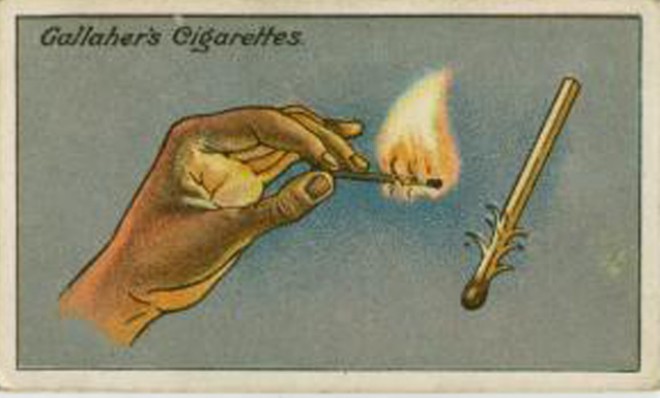Cigarette cards: The life hacks of 100 years ago
WWI-era companies offer advice on how to light a match in the wind, how to stop a mad dog, how to make a fire extinguisher, and more


In the late 1880s, cigarette manufacturers began inserting stiffening cards into their paper packs of cigarettes to strengthen the containers. It wasn't long before they got the idea to put artwork, trivia, famous people, and pretty girls onto those cards, grouped into collectible series. The cards, which continued into the 1940s, are highly valuable now, with the most expensive (bearing the face of stringent anti-smoking baseball player Honus Wagner) selling for $2.8 million in 2007.
In the 1910s, Gallaher Ltd of Belfast & London and Ogden's Branch of the Imperial Tobacco Co printed "How-To" series, with clever hints for both everyday and emergency situations. From steaming out a splinter to stopping a mad dog, these cigarette cards told you the smart way to handle many of life's problems.
(Please note these cards were published a hundred years ago, when safety was not as popular a pursuit as it is now. For that reason, we can't recommend trying any of these, as brilliant as they may be.)
The Week
Escape your echo chamber. Get the facts behind the news, plus analysis from multiple perspectives.

Sign up for The Week's Free Newsletters
From our morning news briefing to a weekly Good News Newsletter, get the best of The Week delivered directly to your inbox.
From our morning news briefing to a weekly Good News Newsletter, get the best of The Week delivered directly to your inbox.
1. How to make a fire extinguisher
"Dissolve one pound of salt and half a pound of sal-ammoniac in two quarts of water and bottle the liquor in thin glass bottles holding about a quart each. Should a fire break out, dash one or more of the bottles into the flames, and any serious outbreak will probably be averted."
"Fill a wide mouthed bottle with hot water nearly to the brim, and press affected part of hand tightly against mouth of bottle. The suction will pull down the flesh, and steam will soon draw out the splinter."
A free daily email with the biggest news stories of the day – and the best features from TheWeek.com
"Eggs for preserving must be newly laid, and by simply putting these into a box or tin of dry salt-burying the eggs right in the salt and keeping it in a cool dry place — it is possible to preserve them for a very long period. No air whatever should be allowed to get to the shell."
"Have decided which side you wish the tree to fall, cut alternatively a downward and inward cut as shown. When about half through, proceed to cut the other side a few inches higher, and finally pull tree down by means of ropes."
"A scout's staff, a walking-stick, or even a handkerchief or hat may be held before you as shown. The dog invariably endeavours to paw down your defense before biting, thus giving you the opportunity of disabling him by a kick."
6. How to keep plants watered while away on holiday
"Fill a large pail with water, and stand it a little above the level of the plants and group round or near as many plants as practical. Loosely plait two or three strands of wool together, immerse completely in water, and place one end in the pail, weighted, and touching the bottom. Rest the other end on the soil: a separate plait of wool is advisable for each pot."
7. How to light a match in the wind
"The familiar difficulty of lighting a match in a wind can be to a great extent overcome if thin shavings are first cut on the match towards its striking end, as shown in the picture. On lighting the match the curled strips catch fire at once; the flame is stronger and has a better chance."
8. How to make a chair to cross a stream
"Fasten a strong rope to a tree and let a boy swim across the stream and fasten the other end to a tree on an opposite bank. Make the chair, fasten it to a running look or a block pulley, and by means of a light rope fastened to the middle of (the) chair and held by a scout at each end, those unable to swim are safely passed over."
9. How to rescue someone from electric shock
"In rescuing a person touched by a "live wire" do not attempt to take hold of him if he is still grasping the wire, unless your hands are protected by rubber gloves, a water-proof coat, or several thicknesses of dry cloth. Stand on glass or dry wood, and try and have (the) current switched off, and send at once for a doctor."
10. How to make a water filter
"A most handy and efficacious filter can be made out of an ordinary perfectly clean zinc water pail, through the bottom of which a hole has been drilled and a small pipe fitted. The water percolates through the layers of fine and coarse sand, and clean picked gravel and stones, with which the pail is filled, filtering through to the bottom in a clear state."
Therese O'Neill lives in Oregon and writes for The Atlantic, Mental Floss, Jezebel, and more. She is the author of New York Times bestseller Unmentionable: The Victorian Ladies Guide to Sex, Marriage and Manners. Meet her at writerthereseoneill.com.
-
 ‘Care fractures after birth’
‘Care fractures after birth’instant opinion Opinion, comment and editorials of the day
-
 Shots fired in the US-EU war over digital censorship
Shots fired in the US-EU war over digital censorshipIN THE SPOTLIGHT The Trump administration risks opening a dangerous new front in the battle of real-world consequences for online action
-
 What will the US economy look like in 2026?
What will the US economy look like in 2026?Today’s Big Question Wall Street is bullish, but uncertain
